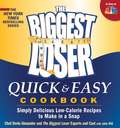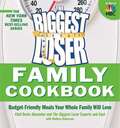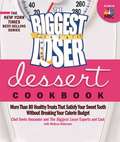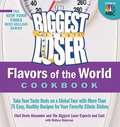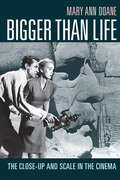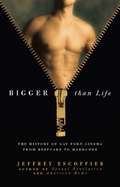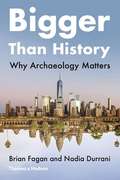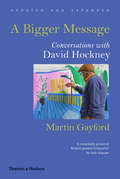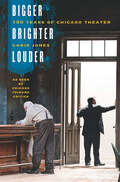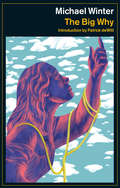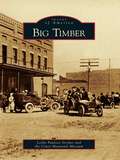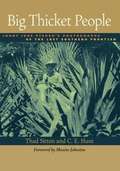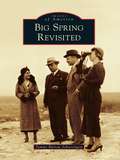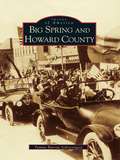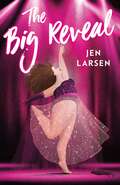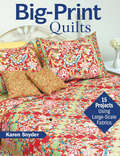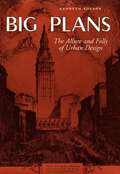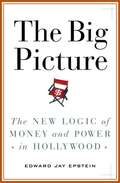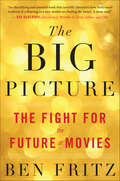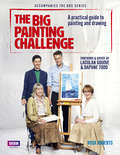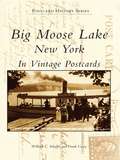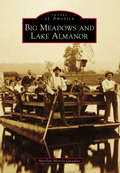- Table View
- List View
The Biggest Loser Quick and Easy Cookbook: Simply Delicious Low-Calorie Recipes to Make in a Snap
by Devin AlexanderThe first cookbook in the bestselling Biggest Loser series to focus on fast, simple meals that you can eat on the go,The Biggest Loser Quick & Easy Cookbook features more than 75 easy recipes with 20 minutes of prep time or less, accompanied by beautiful 4-color photography. The book also provides an overview of The Biggest Loser eating plan; include five 20 minute workouts with tips on how to burn the most calories in the least amount of time, offers healthy cooking and baking tips and techniques as well as shopping lists and pantry basics; and as always, features tips from the trainers and contestants on time-saving techniques for fitting healthy meals into busy schedules. The 75 quick and easy recipes include such categories as breakfast on the double, speedy soups and sandwiches, throw-together salads and sides, mains in minutes, lickety-split sweet bites, and more.
The Biggest Loser Family Cookbook: Budget-Friendly Meals Your Whole Family Will Love
by Devin Alexander Melissa RobersonGrocery costs are on the rise and many family cooks are finding themselves in a tough predicament: how can they feed their families healthy, satisfying meals without breaking the bank? In The Biggest Loser Family Cookbook: Budget-Friendly Meals Your Whole Family Will Love, New York Times best-selling author Devin Alexander shows families that eating on a budget can be easy, nutritious, and delicious. With more than 125 recipes specifically developed to satisfy every member of the family, Chef Alexander provides complete, affordable meal plans for breakfast, lunch, and dinner, along with mix-and-match side dishes, healthy snacks, and desserts. From Swiss Mushroom Omelets to Steak Fajita Quesadillas, Family Sized Meatball Parmesan to Chocolate Cherry Truffles, these wholesome, satisfying dishes will become an essential part of every family cook's repertoire. In addition to an overview of the Biggest Loser eating plan and Chef Alexander's recipes, you'll find helpful cooking and cost-saving tips from favourite Biggest Loser contestants and online club members. You'll also find simple ways to get kids involved in the kitchen and fun ideas for family mealtime. Designed to make healthy eating accessible for everyone, The Biggest Loser Family Cookbook will help pad your wallet not your waistline.
The Biggest Loser Dessert Cookbook: More Than 80 Healthy Treats That Satisfy Your Sweet Tooth without Breaking Your Calorie Budget
by Devin Alexander Melissa RobersonBased on the hit NBC series "The Biggest Loser, The Biggest Loser Dessert Cookbook" by bestselling author Chef Devin Alexander shows readers how to indulge sensibly with more than 80 guilt-free recipes made from wholesome, all-natural ingredients.
The Biggest Loser Around the World: Take Your Taste Buds on a Global Tour with More Than 75 Easy, Healthy Recipes
by Devin Alexander Melissa RobersonPizza. Huevos Rancheros. Pad Thai. Enchiladas. Some of America's most-craved foods aren't American in the traditional sense they're the international foods we love to order at restaurants or have delivered to our homes. But most renditions of these beloved ethnic dishes are full of fat and calories. How can dieters get the flavor they crave, without buying one of those reduced-calorie frozen meals that are full of salt and other preservatives? Now, with The Biggest Loser: International Cookbook , they can have their lasagna and eat it too! With more than 75 recipes for favorite ethnic staples as well as legendary regional American cuisine created by Chef Devin Alexander and The Biggest Loser contestants, healthy eating has never been more exciting. Readers will discover how former contestants reinvented favorite dishes from their own cultures and regions to fit into their healthy new lifestyle, and will learn how to cut the calories and fat from America's most-loved ethnic foods. And Chef Devin Alexander 's reliably decadent creations save both money and calories, as any of these dishes can be made at home for a fraction of the cost of a restaurant or take-out meal. The book will include recipes for meals, snacks, dinners, and desserts, and will cover a wide range of cuisines, from the down-home Southern classics to delicious Asian dishes, Mexican favorites, hearty Italian meals, and many others. The book will also include cooking tips from Chef Devin, weight loss advice from the contestants and trainers, and an overview of the Biggest Loser food plan. The Biggest Loser: International Cookbook will show readers how to expand their culinary horizons without expanding their waistlines!
Bigger Than Life: The Close-Up and Scale in the Cinema
by Mary Ann DoaneIn Bigger Than Life Mary Ann Doane examines how the scalar operations of cinema, especially those of the close-up, disturb and reconfigure the spectator's sense of place, space, and orientation. Doane traces the history of scalar transformations from early cinema to the contemporary use of digital technology. In the early years of cinema, audiences regarded the monumental close-up, particularly of the face, as grotesque and often horrifying, even as it sought to expose a character's interiority through its magnification of detail and expression. Today, large-scale technologies such as IMAX and surround sound strive to dissolve the cinematic frame and invade the spectator's space, “immersing” them in image and sound. The notion of immersion, Doane contends, is symptomatic of a crisis of location in technologically mediated space and a reconceptualization of position, scale, and distance. In this way, cinematic scale and its modes of spatialization and despatialization have shaped the modern subject, interpolating them into the incessant expansion of commodification.
Bigger Than Life: The History of Gay Porn Cinema from Beefcake to Hardcore
by Jeffrey EscoffierHardcore porn?both the straight and gay varieties?entered mainstream American culture in the 1970s as the sexual revolution swept away many of the cultural inhibitions and legal restraints on explicit sexual expression. The first porn movie ever to be reviewed by "Variety," the entertainment industryOCOs leading trade journal, was Wakefield PooleOCOs "Boys in the Sand" (1971), a sexually-explicit gay movie shot on Fire Island with a budget of $4000. Moviegoers, celebrities and critics?both gay and straight?flocked to see "Boys in the Sand" when it opened in mainstream movie theaters in New York, Los Angeles and San Francisco. Within a year, "Deep Throat," a heterosexual hardcore feature opened to rave reviews and a huge box office?exceeding that of many mainstream Hollywood features. Almost all of those involved in making ?commercialOCO gay pornographic movies began as amateurs in a field that had virtually never existed before, either as art or commerce. Many of their ?undergroundOCO predecessors had repeatedly suffered arrest and other forms of legal harassment. There was no developed gay market and any films made commercially were shown in adult x-rated theaters. After the Stonewall riots and the emergence of the gay liberation movement in 1969, a number of entrepreneurs began to make gay adult movies for the new mail order market. The gay porn film industry grew dramatically during the next thirty years and transformed the way men?gay men in particular?conceived of masculinity and their sexuality. "Bigger Than Life" tells that story. "
Bigger Than History: Why Archaeology Matters
by Brian M. Fagan Nadia DurraniAn exciting and much anticipated new archaeology title written by titan Brian Fagan and journalist Nadia Durrani, Bigger than History introduces students to archaeology's contributions to many of today's important debates of interest to students. Each chapter focuses on one of today's important topics, such as gender equality, ethnicity and racism, climate change, and nationality and nationalism, showing how archaeology contributes to our understanding of the issues related to those topics. Bigger than History is affordable and concise enough to be used alongside a textbook, or on its own to engage and draw students into learning about archaeology.
A Bigger Message: Conversations with David Hockney (Revised Edition)
by Martin Gayford“Sumptuously illustrated, this radiant volume encapsulates what it truly means to be a visual artist.” —Booklist David Hockney’s exuberant work is highly praised and widely celebrated—he is perhaps the world’s most popular living painter. But he is also something else: an incisive and original thinker on art. This new edition includes a revised introduction and five new chapters which cover Hockney’s production since 2011, including preparations for the Bigger Picture exhibition held at the Royal Academy in 2012 and the making of Hockney’s iPad drawings and plans for the show. A difficult period followed the exhibition’s huge success, marked first by a stroke, which left Hockney unable to speak for a long period, followed by the vandalism of the artist’s Totem tree-trunk, and the tragic suicide of his assistant shortly thereafter. Escaping the gloom, in spring 2013 Hockney moved back to L.A. A few months later, Martin Gayford visited Hockney in the L.A. studio, where the fully-recovered artist was hard at work on his Comédie humaine, a series of full-length portraits painted in the studio. The conversations between Hockney and Gayford are punctuated by surprising and revealing observations on other artists—Van Gogh, Vermeer, and Picasso among them—and enlivened by shrewd insights into the contrasting social and physical landscapes of Yorkshire, Hockney’s birthplace, and California.
Bigger, Brighter, Louder: 150 Years of Chicago Theater as Seen by "Chicago Tribune" Critics
by Chris JonesThe first known Chicago Tribune theater review appeared on March 25, 1853. An anonymous notice, it shared the page with two other announcements--one about a pair of thousand-pound hogs set to be slaughtered and another trumpeting the largest load of lumber ever to leave Chicago. "And thus Chicago's priorities were starkly laid out right there on that page," begins Chris Jones in the introduction to this eyewitness cultural history. "Hog butcher for the world and windy self-promoter, specializing in commerce-driven superlatives. The arts came a poor third. Critics, and the artists they covered, would rail against that perceived set of civic priorities for years. " The Chicago of today, on the other hand, is regarded as one of the world's premier cities for theater, and no one has had a more consistent front-row seat to its ascendance than the Chicago Tribune theater critics. Bigger, Brighter, Louder weaves together more than 150 years of Tribune reviews into a compelling narrative, pairing full reviews with commentary and history. With a sharp eye for telling details and a keen sense of historical context, Jones, longtime chief Tribune theater critic, takes readers through decades of highs and lows, successes and failures. The book showcases fascinating early reviews of actors and shows that would go on to achieve phenomenal success, including a tryout of A Raisin in the Sun with newcomer Sidney Poitier and the first major review of The Producers. It also delves into the rare and the unusual, such as a previously unpublished Tennessee Williams interview and a long conversation with Edward Albee's mother. With reviews from Claudia Cassidy, Peregine Pickle, William Leonard, and more, many never collected before, Bigger, Brighter, Louder offers a unique lasting record of an ephemeral art and a riveting look at the history behind Chicago's rise to theatrical greatness.
The Big Why: A Novel
by Michael WinterMichael Winter's The Big Why takes the tradition of the historical novel and twists it into the cool, sinuous, entertaining shape we've all been waiting for. His characters are real and from the past, but the lives they live feel contemporary and emotionally modern.Winter's version of the American artist Rockwell Kent is an over aged, erotically fleckless Huck Finn ready to leave the superficial art world of New York and light out for the territory. Only he heads the wrong way: north and east to Brigus, Newfoundland, before and at the beginning of World War One. A socialist and a philanderer, certain in the greatness of his work, he is drawn north by a fascination for the rocky Atlantic coast and by the example of Brigus's other well–known resident, fabled Arctic explorer Robert Bartlett. But once in Newfoundland, Kent discovers that notoriety is even easier to achieve in a small town than in New York. As events come to a head both internationally and domestically and the war begins, Kent becomes a polarizing figure in this intimate, impoverished community, where everyone knows everyone and any outsider is suspect, possibly even a German spy.Writing in Kent's voice, Michael Winter delivers a passionate, witty, and cerebral exploration of what makes exceptional individuals who they are—and why.
Big Timber
by Leslie Paulson Stryker Crazy Mountain MuseumBig Timber, watched over by the Crazy Mountains of Southwest Montana, has always been named for its natural surroundings. Big Timber was originally founded in the late 1800s. An Irish immigrant named the settlement Dornix, from the Gaelic word "durnog," which when translated means "a rock that fits in the hand and is handy for throwing," and there are indeed many such rocks around the region. In 1883, however, when complications with the railroad forced the town to move to its present-day location, it was renamed Big Timber, for the grand and plentiful cottonwood trees along the banks of the nearby Boulder and Yellowstone Rivers. Pioneers began arriving in earnest around 1890, bringing with them sheep, and by 1892, Big Timber was among the world's largest exporters of wool. Later, when a fire devastated the town, the community stood together to rebuild.
Big Thrift Energy: The Art and Thrill of Finding Vintage Treasures-Plus Tips for Making Old Feel New
by Virginia ChamleeLearn to find affordable vintage home decor and how to style it in a modern home.From a Goyard trunk worth upwards of $10,000 (scored for $90) to a floor-length vintage Christian Dior cape (a $10 Goodwill find), Virginia knows how to find deals.Danielle from Apartment Therapy says "Virginia has total sage sister vibes, helping you score pieces for a song with tips that are so good, I kind of can't believe she's letting us in on these trade secrets.&”Picked as a &“Best New Book&” by People Magazine, Big Thrift Energy will teach you everything you need to know about shopping for affordable vintage home decor and styling it in a modern home. Antiquing can be intimidating: how do you know if a piece is worth salvaging? How do you navigate the piles of merchandise at a thrift store or estate sale? Part resource, part inspiration, Big Thrift Energy is a comprehensive guide that offers tips for thrifting that you never knew you needed: How to shop for the good stuff, how to upcycle and style vintage treasures in your home, and even advice for flipping your most-coveted items to turn a profit. Big Thrift Energy will teach you:• Where to shop for antique and vintage treasures you'll love• The best things to buy used, and which items to pass on• How to upcycle something old into something "you" and make it fit beautifully in your home• How to tell when something is valuable, and tips for reselling it to make a profitAuthor Virginia Chamlee has spent more than a decade collecting and selling vintage wares. Her home has been featured on Apartment Therapy and Design*Sponge and her original artwork is available via Chairish, Anthropologie, and Artfully Walls.
Big Thicket People
by Thad Sitton C. E. HuntLiving off the land-hunting, fishing, and farming, along with a range of specialized crafts that provided barter or cash income-was a way of life that persisted well into the twentieth century in the Big Thicket of southeast Texas. Before this way of life ended with World War II, professional photographer Larry Jene Fisher spent a decade between the 1930s and 1940s photographing Big Thicket people living and working in the old ways. His photographs, the only known collection on this subject, constitute an irreplaceable record of lifeways that first took root in the southeastern woodlands of the colonial United States and eventually spread all across the Southern frontier. Big Thicket People presents Fisher's photographs in suites that document a wide slice of Big Thicket life-people, dogs, camps, deer hunts, farming, syrup mills, rooter hogs and stock raising, railroad tie making, barrel stave making, chimney building, peckerwood sawmills, logging, turpentining, town life, church services and picnics, funerals and golden weddings, and dances and other amusements. Accompanying each suite of images is a cultural essay by Thad Sitton, who also introduces the book with a historical overview of life in the Big Thicket. C. E. Hunt provides an informative biography of Larry Jene Fisher.
Big Spring Revisited
by Tammy Burrow SchrecengostIn West Texas, the land that would one day become Big Spring was originally home to Comanche Indians. In 1880, the Texas Rangers were sent ahead of the railroad to establish peace among the ranchers and to protect the western frontier from the Comanche who lived there. New Texans began to follow the railroad from Colorado City to Big Spring, which was named the county seat of Howard County in 1882. The small Texas town once known for its saloons, dance halls, shoot-outs, and gambling grew into an oil- and agriculture-rich community. This pictorial collection illustrates the continual progress that Big Spring has made, from the first wooden buildings thrown together on First and Main Streets to the discovery of oil. Big Spring also experienced economic booms with the building of an oil refinery, an air force base, and the rise of the cattle industry. Today this once-small West Texas town is dotted with wind farms, an oil refinery, and three hospitals.
Big Spring and Howard County
by Tammy Burrow SchrecengostWhile Native Americans had been visiting the oasis at the cross roads of the Comanche War Trail for hundreds of years, Captain Randolph Marcy was the first White man to "discover" the springs on October 3, 1849. Settlers moved their families to the area, and the region quickly developed into a ranching and farming community. Captured here in over 200 vintage images are the trials and triumphs of settlers and residents to build a life in Big Spring and the towns of Howard County.As the first settlers began setting up stakes in the region, a tent city was built at the springs while awaiting the arrival of a railway. Once the train was in service, Big Spring began to develop more permanent dwellings; schools, churches, and a newspaper were established, followed quickly by the building of hotels and banks and the formation of a local government. Featured here are over 150 years of the region's residents, homes, and social events, covering the many towns and communities of the County such as Forsan, Coahoma, Lomax, Elbow, Garden City, Knott, Vealmoor, Ackerly, and Vincent.
The Big Reveal
by Jen LarsenAddie is a talented dancer, a true-blue friend, and a fat, fierce, and driven young woman. When she's accepted into the prestigious dance company of her dreams, she thinks nothing can bring her down—until she realizes she doesn't have enough money to go. Refusing to give up, Addie and her friends decide to put on a top-secret, invitation-only burlesque show to raise funds. But word soon gets out, and the slut- and body-shaming begin. Has Addie been resisting the patriarchy, or playing right into its hands?The Big Reveal asks hard-hitting feminist questions while reveling in some of life's greatest joys: chasing your passions, falling in love, and embracing yourself exactly as you are.
Big-Print Quilts: 15 Projects Using Large-Scale Fabrics
by Karen SnyderToday's marketplace is flooded with trendy large-scale prints from design visionaries including Amy Butler and Heather Bailey. Big-Print Quilts comes to your rescue, helping you turn your longing looks at today's impressive large-scale floral or novelty fabrics into great ideas and actions for making the most of these innovative prints. This book features 15 projects for every quilting skill level, plus, charts to help you stitch your way through varying fabric scales. Big-Print Quilts gives you license to quilt big, and not look back!
Big Plans: The Allure and Folly of Urban Design (Center Books on Contemporary Landscape Design)
by Kenneth KolsonBig Plans: The Allure and Folly of Urban Design springs from the idea that human aspirations for the city tend to overstate the role of rationality in public life. Inspired by the architectural and urban criticism of such writers as Lewis Mumford, Jane Jacobs, and John Brinckerhoff Jackson, Kolson adopts a user's perspective on issues of urban design, an approach that highlights both the futility of social engineering and the resilience of the human spirit.
Big Plans: The Allure and Folly of Urban Design (Center Books On Contemporary Landscape Design Ser.)
by Kenneth Kolson“Similar in spirit to Lewis Mumford’s The City in History and Jane Jacobs’ The Death and Life of Great American Cities . . . wonderful, funny, idiosyncratic.” —Frederick R. Steiner, author of The Living LandscapeBig Plans: The Allure and Folly of Urban Design springs from the idea that human aspirations for the city tend to overstate the role of rationality in public life. Inspired by the architectural and urban criticism of such writers as Lewis Mumford, Jane Jacobs, and John Brinckerhoff Jackson, Kolson adopts a user’s perspective on issues of urban design, an approach that highlights both the futility of social engineering and the resilience of the human spirit.“A book that should be read by all those people, and there seem to be more of them as week chases week, who are thinking about the fate of lower Manhattan right now.” —Bloomberg News“Kenneth Kolson has lots of material: Some of what’s been built in cities lately is astonishing and not in a good way.” —The Boston Globe“Kolson is a passionate critic of urban schemes, with well-founded skepticism about the role rationality has played in designing them.” —Journal of the Society of Architectural Historians“A fascinating read about the utopian goal of Big Plans and the dystopian reality of lived experience.” —Design Issues
The Big Picture: Money and Power in Hollywood
by Edward Jay EpsteinIn this unprecedented, all-encompassing, and thoroughly entertaining account of the movie business, acclaimed writer Edward Jay Epstein reveals the real magic behind moviemaking: how the studios make their money. Epstein shows that in Hollywood, the only art that matters is the art of the deal: Major films turn huge profits not from the movies themselves but through myriad other enterprises, from video-game spin-offs and soundtracks to fast-food tie-ins, and even theme-park rides. The studios may compete for stars and Oscars, but their corporate parents view with one another in less glamorous markets such as cable, home video, and pay-TV. Money, though, is only a small part of the Hollywood story; the social and political milieus–power, prestige, and status–tell the rest. Alongside its remarkable financial revelations and incisive profiles of the pioneers who helped build Hollywood, The Big Picture is filled with eye-opening insider stories. If you are interested in Hollywood today and the complex and fascinating way it has evolved in order to survive, you haven’t seen the big picture until you’ve read The Big Picture.
The Big Picture: The Fight for the Future of Movies
by Ben FritzA Los Angeles Times Bestseller Winner of the Best Non-Fiction Book Prize at the 2018 National Arts & Entertainment Journalism Awards &“Ben Fritz crafts an electrifying and essential book that carefully chronicles how Hollywood tradition is collapsing and new models are fueling the future. A must-read.&”—Ava DuVernay, director of A Wrinkle in Time, Selma, and 13th The stunning metamorphosis of twenty-first-century Hollywood and what lies ahead for the art and commerce of film Ben Fritz chronicles the dramatic shakeup of America&’s film industry, bringing equal fluency to both the financial and entertainment aspects of Hollywood. He offers us an unprecedented look deep inside a Hollywood studio to explain why sophisticated movies for adults are an endangered species while franchises and super-heroes have come to dominate the cinematic landscape. And through interviews with dozens of key players at Disney, Marvel, Netflix, Amazon, Imax, and others, he reveals how the movie business is being reinvented. Despite the destruction of the studios&’ traditional playbook, Fritz argues that these seismic shifts signal the dawn of a new heyday for film. The Big Picture shows the first glimmers of this new golden age through the eyes of the creative mavericks who are defining what entertainment will look like in the new era.
The Big Painting Challenge
by Rosa RobertsAre you ready to release your inner artist? The Big Painting Challenge is a revolutionary guide to painting and drawing, to accompany the new BBC series presented by Una Stubbs and Richard Bacon. Packed with practical information, useful exercises and accessible projects in almost every medium, it will give you the confidence you need to express your artistic side. Whether you want to work with charcoal or ink, acrylics or watercolours, you’ll gain skills quickly and easily, moving from warm-up exercises and first sketches through to full paintings. You’ll be amazed at what you can create with just a few simple principles, some basic materials, and a bit of inspiration! Fully illustrated and including 18 step-by-step projects, from landscapes and portraits to still life and seascapes, The Big Painting Challenge is an essential introduction to the world of visual art.
The Big One: The Cascadia Earthquakes and the Science of Saving Lives (Scientists in the Field Series)
by Elizabeth RuschNo one ever thought the Pacific Northwest was due for an earthquake, let alone a catastrophic one. But geologists are transforming our understanding of the grave dangers the population in the region of Cascadia face—will there be a big one? And what can be done to save lives? America's Pacific Northwest has relatively few earthquakes—only a handful each year that cause even moderately noticeable shaking. But a couple decades ago, scientists discovered a geological feature running along the coast that in other parts of the world regularly triggers massive earthquakes of 8.0 magnitude and higher. Were there once massive earthquakes in this part of the world? Geologists think there were. Now a small group of scientists are studying things that you might not think have anything to do with earthquakes—marsh soil, ocean sediments, landslide debris, and ghost forests—and they have reason to believe that the Pacific Northwest is likely not as idyllic as it was once assumed. The population is likely in grave danger of a massive earthquake at some point. What can be done? The big one can't be stopped, but scientists are working tirelessly to learn as much as they can to prepare.
Big Moose Lake, New York in Vintage Postcards (Postcard History)
by William L. Scheffer Frank CareyFrom the 1890s through the 1920s, the postcard was an extraordinarily popular means of communication, and many of the postcards produced during this "golden age" can today be considered works of art. Postcard photographers traveled the length and breadth of the nation snapping photographs of busy street scenes, documenting local landmarks, and assembling crowds of local children only too happy to pose for a picture. These images, printed as postcards and sold in general stores across the country, survive as telling reminders of an important era in America's history. This fascinating new history of Big Moose Lake, New York, showcases more than two hundred of the best vintage postcards available.
Big Meadows and Lake Almanor
by Marilyn Morris QuadrioFew among the thousands of vacationers who recreate on and around Lake Almanor each summer realize that beneath its waters lie the remains of a vanished way of life. This tiny Atlantis, Big Meadows, was a microcosm of the cultural forces and conflicts that racked the West in the 19th and early 20th centuries. Rich in natural resources, the Meadows sustained the lives of the native Maidu and the hundreds of encroaching whites who followed on the heels of the Lassen Trail immigrant parties. White men came seeking to exploit those precious resources for gold mining, stock raising, dairying, tourism, timber, and later, hydroelectric power. In the tumult of cultural and industrial change, a pastoral way of life was lost and a native culture vanquished.
